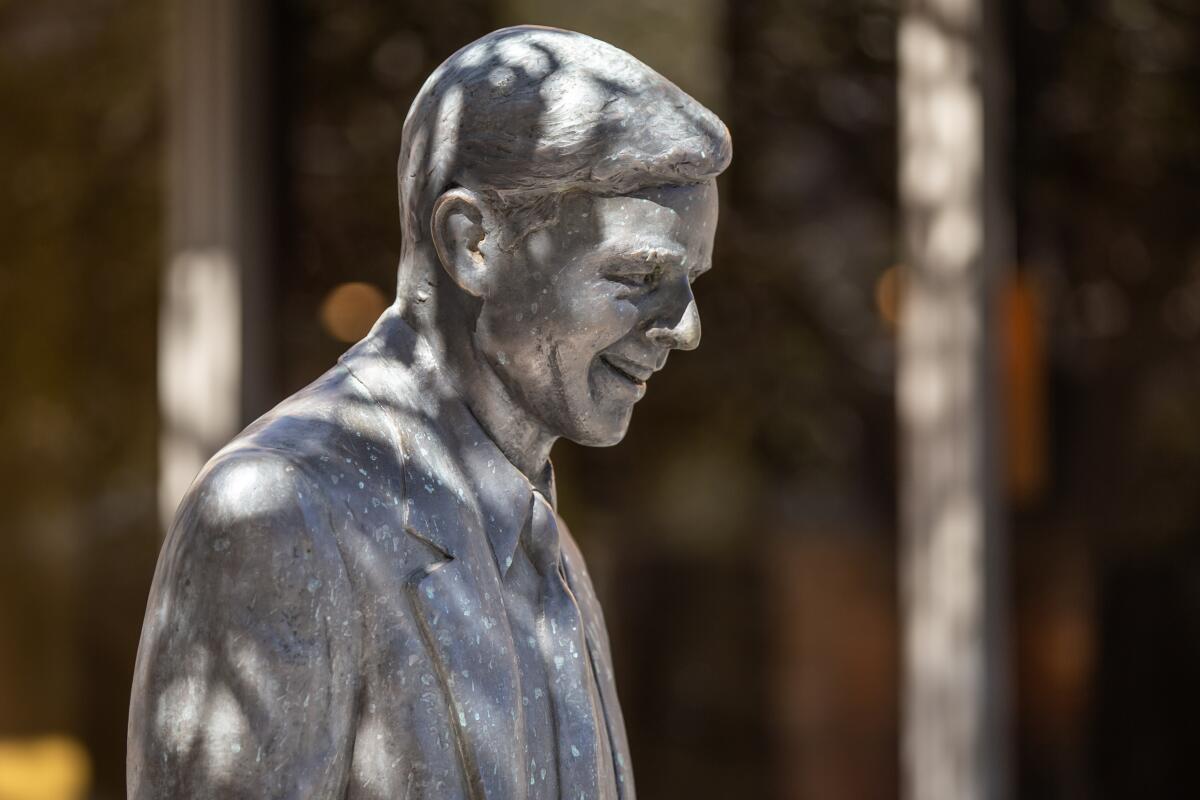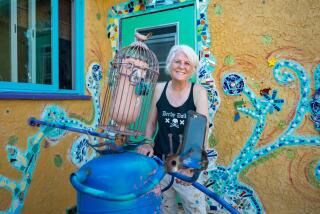Column: The most controversial thing about Gov. Pete Wilson’s statue is its dull irrelevance
SAN DIEGO — If you want a lesson in the power of monuments to influence hearts and minds and whitewash the past, look no further than the statue of former California Gov. Pete Wilson.
It stands forlorn and mostly forgotten in downtown San Diego, next to a Panera Bread. The life-sized bronze replica captures Wilson in all his Midwestern milquetoast glory. The boyish smile. The helmet of hair. The hands in the pockets of pleated pants.
This oversized trophy is now spotted with oxidation, and nowhere near as shiny as it was during its 2007 unveiling, when 500 fans and 300 protestors faced off.
It’s been in the news recently, after local Latino and LGBTQ groups began a campaign to remove it in the same spirit that toppled effigies of Confederates across the South and Father Junipero Serra in California.
In recent years, Wilson’s long political career — two-term U.S. senator and governor, former assemblyman, boy-wonder San Diego mayor — has been largely overshadowed by his endorsement of Prop. 187, the 1994 ballot initiative that sought to make life miserable for undocumented immigrants but instead inspired a generation of Latinos to vote Democrat.
The activists claimed victory in October when the nonprofit Horton Walk, which that owns the Wilson statue, removed it under the premise that the move was to ensure its safety.
But Horton Walk reinstalled the monument on Nov. 30, with little explanation other than a news release by President Stephen Williams that stated, “The statue of Pete Wilson is a symbol of all that is great about San Diego and its unlimited future.”
So I decided to hang out near it and ask people what they thought about the controversy.
I expected a lively debate about his merits, and whether cancel culture is going too far. Instead, I got an education about a Wilson I didn’t know.
A titan of trolleys.
I started with Bruno, a valet worker who waited for cars that never came at a Westin hotel across the street from the Wilson statue. Did he know about the metal man whose likeness was within our eyesight?
“He was the guy who brought the trolley, I forget his name,” said the older chap with a European accent.
I asked the same question to Kristen, the Panera Bread manager, who declined to give her last name.
“He developed Horton Plaza, didn’t he?” said the 31-year-old.
“The trolley!” a customer volunteered.
Outside Panera, David Johnson walked his border collie. “He was a politician, right?” said the 42-year-old. “Something about trolleys.”
I then chased down 16-year-olds Kassy Elizondo and Gilbert Sanchez, who had just walked past the Wilson shrine.
“He had something to do with trolleys,” Gilbert said.
My mind was spinning: What the hell was all the talk about trolleys?
Then I realized why everyone kept mentioning them as I saw Sanchez stare toward Wilson’s feet.
A plaque featured the name of more than 200 donors who raised $200,000 to make the statue possible, a Who’s Who of Old San Diego surnames: Copley. Spanos. Issa. Moores. Manchester.
Another one proclaimed that the redevelopment of downtown San Diego was “one of [Wilson’s] proudest achievements.” Next to it was an engraving of the man of the moment.
In front of a streetcar.
Boasting that Wilson’s greatest accomplishment was bringing light rail to San Diego was like saying the pinnacle of George Washington’s life was as a whiskey distiller. Or for Ronald Reagan, his days as a broadcaster for University of Iowa football games.
Wilson is one of the most consequential figures in California history, someone who almost single-handedly changed our trajectory with his endorsement of 187.
But the statue’s mise-en-scene is more fuddy-duddy than a rotary phone, and about as dynamic as butcher paper.
I can’t believe I’m about to say this, but here it goes:
Pete Wilson deserves better.

Even California’s Latino Legislative Caucus, composed largely of state senators and assemblymembers who entered politics to spite what Wilson stood for, paid more respect to Wilson with a tongue-in-cheek thank-you video released last year to mark the 25th anniversary of 187.
One of the participants was San Diego-area Assemblywoman Lorena Gonzalez, who admitted she was “shocked” that Wilson’s statue had reemerged.
“If they want to put it in the GOP headquarters, that’s fine, but it’s not a unifying vision for San Diego,” she said. She noted all the construction in downtown before adding: “They should just take it out. When Horton Plaza is rebuilt, then we can come together as a community and decide what’s unifying.”
But that’s the thing: Almost everyone I talked to was agnostic about seeing the Wilson statue sent to the scrap heap.
They got quiet when I explained what Prop. 187 sought to do, and Wilson’s involvement with it. But when I mentioned the current controversy surrounding his monument, only Kassy wanted it taken down.
“They put stuff on [Wilson] that happened years ago,” said Bruno. “Everyone makes a mistake. Keep it. It’s not like he was a killer.”
“He did good for San Diego,” said Johnson.
Kristen sounded more conflicted.
“Do you want something to remain that negatively represents your town?” she said, as her eyes scrunched in thought. “But it’s tough, because it’s history. Are we going to take down all statues that are negative?”
The power of trolleys, man.
But that’s the thing with monuments, said UC Davis professor Javier Arbona, a specialist in the subject.
“They don’t really educate us about the past,” he said. “They tell us more about the contemporary. In a sense, they help erase or forget things about the past and re-create something rather hazy that redraws what the future is about.”
And after that whitewashing happens, Arbona added, people generally doesn’t want a monument taken down, even if they aren’t particularly enamored of it.
“People understand [their removal] as a desecration,” he said. “It’s a strong kind of public sense that certain things are more permanent than fast food, that they’re heritage and therefore have to be respected. It’s very powerful.”
I reached out to Williams for response, but the real-estate developer sent me the same boilerplate Nov. 30 news release he previously released. And after longtime associate Sean Walsh told me he’d make Wilson available for comment, he never did.
His statue stands on private property, so it’s not going anywhere. Nor can activists install any sort of counter-monument without property management removing it posthaste.
I say let it stand. It’s such an apt metaphor for Wilson. A man who was a political giant in his time, but one that history will judge harshly. So harshly that even his fanboys didn’t dare highlight the totality of the man in their public homage, and so reduced him to as anodyne an accomplishment as possible.
Trolleys.
More to Read
Sign up for Essential California
The most important California stories and recommendations in your inbox every morning.
You may occasionally receive promotional content from the Los Angeles Times.











